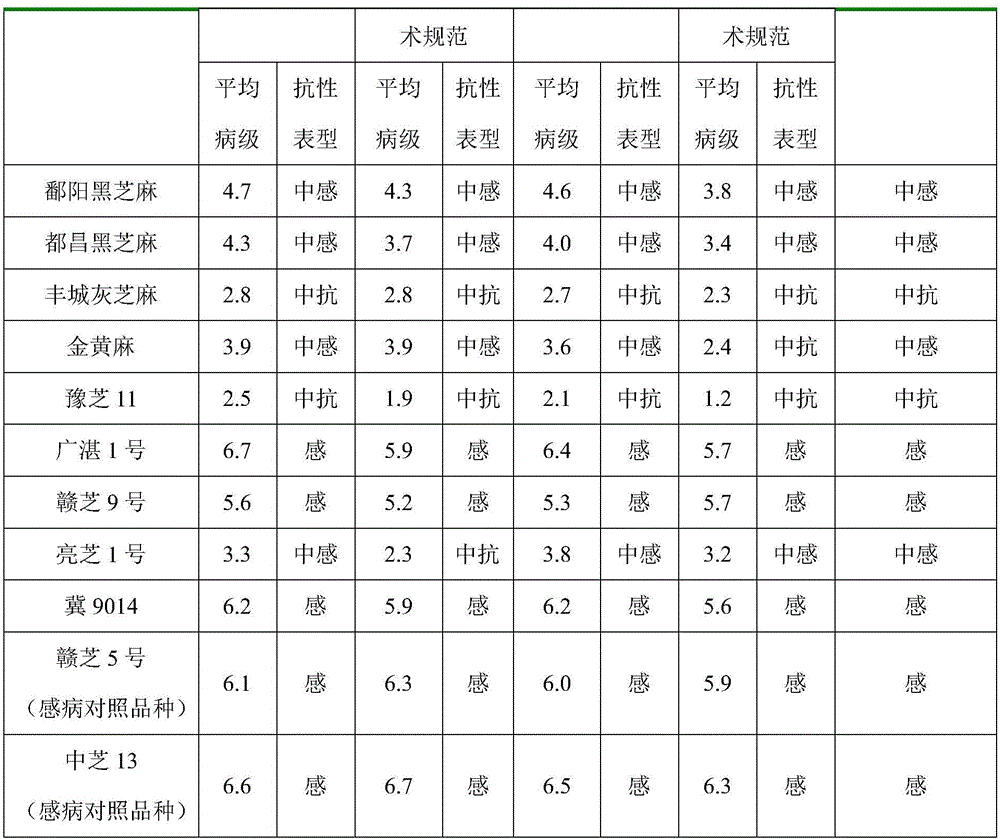Field high-flux identification method for bacterial wilt resistance of sesamum indicum varieties
An identification method and anti bacterial wilt technology, applied in the field of disease resistance identification, can solve the problems of low identification efficiency, poor accuracy and repeatability, etc., and achieve real identification results, improve accuracy and repeatability, and save costs. Effect
- Summary
- Abstract
- Description
- Claims
- Application Information
AI Technical Summary
Problems solved by technology
Method used
Image
Examples
Embodiment 1
[0037] This example provides a high-throughput field identification method for the resistance of sesame varieties to bacterial wilt. It includes the following steps:
[0038] 1) Sesame bacterial wilt natural identification disease nursery cultivation: select areas where sesame bacterial wilt often occurs, and select fields with flat terrain and uniform fertility, and plant the highly susceptible variety Ganzhi No. 5 to its fields for 3 consecutive years After the rate of diseased plants is not less than 90%, select the field as a natural identification disease nursery in the second year;
[0039]2) Soil preparation and sowing: before sowing, use Jinduer to carry out closed weeding to the natural identification disease garden, apply 25kg of base fertilizer in the natural identification disease garden of every 667 square meters, wherein, the total content of nitrogen, phosphorus and potassium in the base fertilizer is 45wt%, the ratio of nitrogen, phosphorus and potassium is 6:...
Embodiment 2
[0062] This example provides a high-throughput field identification method for the resistance of sesame varieties to bacterial wilt. It includes the following steps:
[0063] 1) Sesame bacterial wilt natural identification disease nursery cultivation: select areas where bacterial wilt often occurs in sesame, and select fields with flat terrain and uniform fertility, and plant the highly susceptible variety Zhongzhi 13 for 4 consecutive years until its field disease After the plant rate is not lower than 90%, select the field as the natural identification disease nursery in the second year;
[0064] 2) Soil preparation and sowing: before sowing, use Jinduer to carry out closed weeding to the natural identification disease garden, apply 30kg of base fertilizer in the natural identification disease garden of every 667 square meters, wherein, the total content of nitrogen, phosphorus and potassium in the base fertilizer is 40wt%, the ratio of nitrogen, phosphorus and potassium is...
Embodiment 3
[0084] This example provides a high-throughput field identification method for the resistance of sesame varieties to bacterial wilt. It includes the following steps:
[0085] 1) Sesame bacterial wilt natural identification disease nursery cultivation: select areas where sesame bacterial wilt often occurs, and select fields with flat terrain and uniform fertility, and plant the highly susceptible variety Ganzhi No. 5 to its fields for 2 consecutive years After the rate of diseased plants is not less than 90%, select the field as a natural identification disease nursery in the second year;
[0086] 2) Soil preparation and sowing: before sowing, use Jinduer to carry out closed weeding to the natural identification disease garden, apply 20kg of base fertilizer in the natural identification disease garden of every 667 square meters, wherein, the total content of nitrogen, phosphorus and potassium in the base fertilizer is 50wt%, nitrogen, phosphorus, and potassium ratio of 7:3:7; ...
PUM
 Login to View More
Login to View More Abstract
Description
Claims
Application Information
 Login to View More
Login to View More - R&D
- Intellectual Property
- Life Sciences
- Materials
- Tech Scout
- Unparalleled Data Quality
- Higher Quality Content
- 60% Fewer Hallucinations
Browse by: Latest US Patents, China's latest patents, Technical Efficacy Thesaurus, Application Domain, Technology Topic, Popular Technical Reports.
© 2025 PatSnap. All rights reserved.Legal|Privacy policy|Modern Slavery Act Transparency Statement|Sitemap|About US| Contact US: help@patsnap.com



